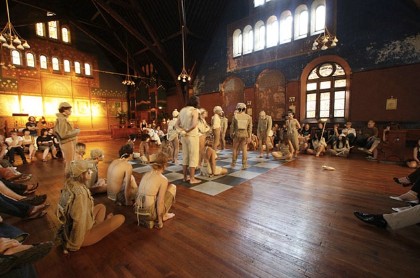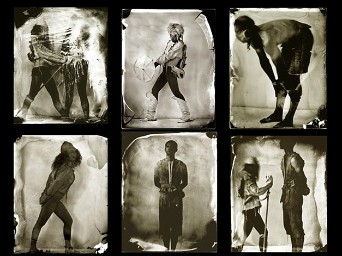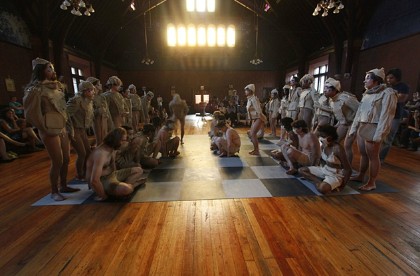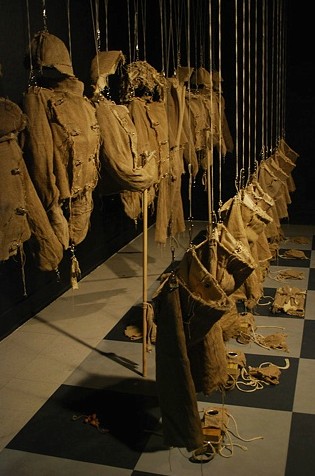Interview with Liliya Lifanova |
Yun: It was great to see your work when I was at the artist residency in Spain. For myself, I have been interested in the form of stories as an archetype but I feel my projects related to this interest have not yet been successful. So when I saw your “Anatomy is Destiny,” I believe that by setting up a field and characters, you are creating a machine that is making an endless story by itself. The phrase “anatomy is destiny,” from Freud, has been used in the context of feminism for some time.
Anatomy is Destiny View a 10 minute arrangement of this performance at the Church of the Epiphany, Chicago: | But in your performance, the tension created by the chessmen seems to
indicate the energy of an organ before it has a specific character, such as the
states of the malfunction or limitations of anatomy. When you started the Project Flying Carpet (2011) you also
created some types of structure on the each location that you visited. Would
you please introduce how you started your projects, “Anatomy is Destiny” and
“Project Flying Carpet,” and when did you first become aware of and interested
in the narrative structures? Liliya: When it comes to performance, I always start the same: I work in isolation on my Rolled Series. I work very slowly, so my body builds a lot of tension, my mind starts to obsess, like a splinter it catches on things I want to manifest. It leads me to do research, not always in any linear way, but I follow it blindly. |
With Anatomy is Destiny I simply remember that I first stumbled upon this chess match, which intrigued me… and the rest was like a puzzle. Archetypes are tools that help me direct. The archetypes build a story where there isn’t one. For Anatomy is Destiny, I looked at a lot of literature that assigned specific qualities to each chess piece. I looked at all of it without judgment and as I was making the garments and props I thought about whether those archetypes would be valid if I were a Rook a Pawn, etc. Later, I suggested some things to my collaborators and the cast, but really tried to stay out of their way. The things I wanted to control were already in place, and now it was their game. So the game like you say is in a state of a developing organ, the people that embody it render its nature. It was interesting for me to think of the title not only in regard to gender but also mainly in regard to class. And borrowing the title from Freud, I linked it with Marcel Duchamp’s match against himself as a woman. Project Flying Carpet unraveled as a result of many things, the strongest among them were the ideas of impermanence, of displacement, of buoyancy and of recognition of the fact that my own biography positions me as a kind of an artifact. |  Anatomy is Destiny, Performance at the Church of the Epiphany, Chicago.2009 Photo by Karina Natis |
Every culture has a version of a Flying Carpet and in each of them there is an individual that steers it for the ultimate benefit of his/her people. I had trouble entering that type of character. I felt less like a hero and more like an adventurer, my travels having to do with a selfish but uncontrollable desire to explore. The way I adopted the narrative served my own needs. Also, because I have an ongoing project called Artist In Your Residence, the idea of a Flying Carpet worked as a vehicle that propels me from one place to the next.
click to Next page
About Anatomy is Destiny 1.1 Introduction:
When Freud coined the phrase "Anatomy is Destiny," he was referring to either having or lacking the phallus, a random act of fate foreshadowing the menace and anguish of the haves and have-nots. The illusiveness of this position, as well as its absoluteness, is well illustrated by chess in which the champion's title is continually lost and obtained from one moment to the next with the imminent determinacy of a clear victor up for grabs. In my performance Anatomy is Destiny, I utilized as a script the record of Marcel Duchamp's match against himself as Rrose Selavy, his female (and in this game also his aggressive and hysterical) alter-ego. Visually underlining this dialectical battle of destiny and free will in Anatomy is Destiny, I seek to underline the value not only of the end result, but also the importance of experiencing the process and facing the challenge. Comprised of 32 participants dressed in specially designed garments that restrict their movements, thereby also defining their role within the game, this performance takes place on a life-size chessboard. As the performers make their moves, their journeys on the chessboard are traced by noise-making props attached to their garments, while their feet move through the boudaries of the checkered ground. After 40 motions by each player, lasting approximately 40 minutes, the match ends in a tie. |  Untitled 2009 Wet Plate Collodion Prints by Kari Laine McCluskey |
Anatomy is Destiny: Demo  Anatomy is Destiny, Performance at the Church of the Epiphany, Chicago. 2009 1.2 Background:
A chess game is something very plastic. You build it. It is a mechanical sculpture, with chess one creates beautiful problems and this beauty is made with the head and the hands. –Marcel Duchamp The game of chess is like a language. Its pieces are known archetypes that transcend the differences among cultures and generations, uniting the experience of the human kind into the following cycle: pride, conquest, victory, defeat, frustration, withdrawal, repentance, resolution, then once more, pride, the wheel of life. When I study a transcript of a chess match between two players, within a short period of time I can see each person's aggression, defense, victory, and defeat expressed through the language of the relational. In each game, a common narrative begins to emerge, a metaphor for the complex system of life itself expressed through the abstract and silent pursuit of the bottomless truth, or the full acceptance of the absence of it and the continual re-creation of one gradually sculpted in time. Like painting, drawing, and mathematics, playing chess shuts down the left side of the brain, leading the player to become almost unaware of chronological time. In a chess match, therefore, the player is able to represent "the fourth dimension" in which, via manipulation of mere matter, notions of time and space are removed, resulting in the "now you see/hear it, now you don't" quality of time-based works. |  Anatomy is Destiny, The Wardrobe: A Game in Waiting.2009 When a practiced player is engaged in chess, decisions are made based on relations and the possibilities contained within such relationships, enabling the player to reach the state of "no mind" or "Buddha mind". This state, where the use of words ceases to be useful, exerted a powerful pull on Duchamp as illustrated by Jacquelynn Baas in the essay "Unframing Experience." The transcript of a chess match between Duchamp and Rrose Selavy recorded by Armand P. Arman is a work of art that takes up a page and a half in the catalogue entitled "Marcel Duchamp, Plays and Wins." It claims to be a record of a game that happened at a swift chess championship in New York. Arman's commentary on each of Duchamp's moves inspired me to manifest the script as a performance, visually interpreting each piece's aesthetic identity through restrictions placed on the body via costumes. The opposing teams are dressed in duplicate, varying only in the type of cloth used—one lighter, the other the darker side. Upper limbs are not essential to moving around the board; I bind the players, thus, accentuating their slightest differentiations each step of the way as as these “pieces” methodically travel the grided space of the board. Pawns for example, wear only shorts and are bound at their wrists to a log displaying a vividly unfortunate dealing of their destiny. Having collaborated with a choreographer Davy Bisaro, a unique series of movements were generated to suit each piece. Artist Sebastian Alvarez contributed to the project by creating sound props that each performer engages as he/she moves on the board.
Inherent in chess, are also issues of class and themes of fate versus free will. Neither one nor the other but both at the same time, the game of chess allows for a pondering of these eternal questions within an area of 64 squares with endless possibilities. Two versions comprise Anatomy is Destiny. a) An installation entitled The Wardrobe: Game in Waiting comprised of vacant garments housed at Gallery X at the School of the Art Institute of Chicago, and b) three public performances in which the garments are activated by the participating crew.
click to Next page |